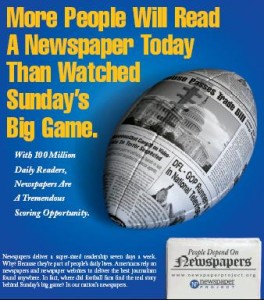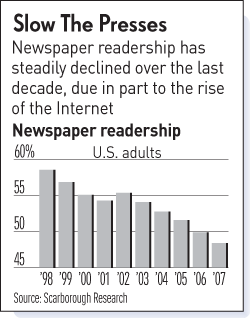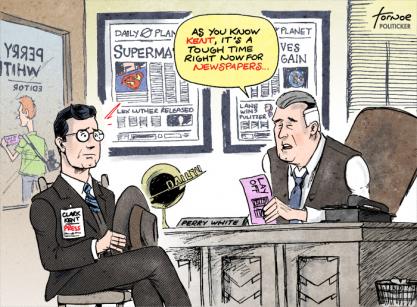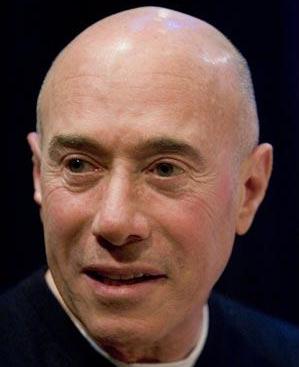
David Geffen
Will The New York Times Co. go under? Don’t bet on it, says Fortune magazine. Sure, the Times has significant business challenges, and it’s actively looking for ideas to rescue its business, but there is no shortage of investor interest in the Old Gray Lady. Hollywood mogul David Geffen reportedly made an unsuccessful play to buy the 19% stake in the Times held by hedge fund Harbinger Capital Partners recently, Fortune says. Google also seriously considered investing in the Times before deciding against the move. Meanwhile, the controlling Sulzberger family publicly says they’re not interested in selling.
The Times has a lot of problems on the business end, but its brand equity is the envy of the industry. The problem is, at current run rates, the company will be insolvent in two years. Rather than going under, it’s more likely that the Times will be picked up by one or more wealthy investors who are already knocking at the door or will radically change its business model.
Newsweek reports that Geffen’s overture was made with the intention of converting the Times to a nonprofit institution under a structure similar to that created by the late Nelson Poynter, whose nonprofit Poynter Institute runs the St. Petersburg Times. That paper has suffered along with everyone else, but its nonprofit status gives it some wiggle room to absorb losses, and it’s increasingly attracting attention for the quality of its work, including two Pulitzer prizes last month.
Inside the Times, there’s a working group studying the options for radical transformation. If all options are indeed on the table, then the Times could be looking at a much smaller and more focused editorial model. Thomson Reuters CEO Tom Glocer got some attention last month by suggesting that the Times could get by with a staff of as few as 60 reporters by cutting back on nonessential coverage and partnering for the rest. That idea isn’t likely to be popular at a paper known for its vast resources, but the Times could set a standard for the industry by reshaping its self around a partnership model.
Baltimore Sun: Retooling or Shutting Down?
The Politico writes of the “Dark Day at Baltimore Sun“ in a piece that reads like an epitaph. The Sun‘s newsroom staff has been cut back from a high of 420 people to just 140. The paper recently closed its bureau covering Annapolis, the state capitol. Two columnists recently sent to cover an Orioles game were laid off before the ninth inning. Coverage of Washington has been outsourced to pool reporters from parent Tribune Co.
Executives say it’s all part of the process of retooling the Sun into an Internet-ready machine. “”If you’re looking to transform yourself, you really better stop looking at yourself as a newspaper company rather than as a digital media company,” says Monty Cook, the paper’s new editor. He said the Sun continues to devote itself to “watchdog journalism,” but admits that “the days of the six-part series are gone.” That’s probably true. The investigative team at the paper, which once numbered four reporters, is down to one person.
Editors See Brighter Future
The Associated Press Managing Editors survey finds a wellspring of optimism about the likelihood that newspapers will return to profitability. Just 17% of the editors surveyed said they believed the industry would go extinct while 60% said they’ll be profitable again. However, respondents overwhelmingly said they are having a harder time delivering quality information to their readers, which is not surprising giving the nearly 20,000 job cuts in the industry over the last 18 months.
Editors continue to be caught in a cost-cutting cycle that limits their ability to think outside the box. Fifty-seven percent said they didn’t have enough money to innovate and 31% said their people don’t have the skills to change with the times. Nearly 40% said they are devoting more space to “hyper-local” news, which is surprisingly low given the trends in reader news consumption. Nearly three in four said they’re sticking it out because they believe in “the mission of journalism.”
Most chilling quote: “”Our newspaper’s biggest revenue source today is foreclosure notices,” said Clifford Buchan, editor of the Minnesota-based weekly Forest Lake Times.
Miscellany
Investor John W. Rogers Jr. says it’s time to buy Gannett Co. Yes, media stocks are beaten down, says Rogers, who’s chairman and CEO of Chicago-based Ariel Investments, but “when a company with strong franchises like Gannett sells for one times trailing earnings and three times expected 2010 earnings, I step up and swing.” Rogers says newspaper companies are highly vulnerable to trends in cyclical markets like automobiles and real estate. Once those sectors recover, though, growth should return.
It isn’t over yet for the Tucson Citizen. A federal judge is expected to rule today on whether the Citizen, which formally closed down on Saturday, must resume publication. Arizona Attorney General Terry Goddard argued that Gannett Co. and Lee Enterprises violated antitrust laws by closing down the weaker of the two players in a joint operating agreement between the Citizen and the Arizona Daily Star in order to wring more money out of the surviving property. A core shutdown staff of eight people remains at the Citizen, and it’s unclear how many staffers could be recalled to restart the paper if the judge so orders.
The Ann Arbor News will publish its last issue on July 23. The paper announced plans to shut down back in March, but we didn’t know a precise date until now. An online version will continue to pump out news 24X7.
At least 14 news ombudsmen have lost their jobs in the past year, writes Andrew Alexander, who holds that title at the Washington Post. Among the reasons: ombudsmen are considered less essential to the editorial function than reporters and a new crop of bloggers is now filling some of the watchdog role. However, ombudsmen may be more important than ever, Alexander writes, noting that he is on track to receive more than 50,000 reader messages this year. “They want an informed judgment from a professional journalist who has been empowered by management to directly confront reporters and editors with unpleasant questions.” Kevin Klose, the new dean of the J-school at the University of Maryland, has suggested that a consortium approach could provide the same reader-advocacy function for less money.
 If the new owners of the San Diego Union-Tribune are planning to reinvent the news operation, they made a surprising choice in
If the new owners of the San Diego Union-Tribune are planning to reinvent the news operation, they made a surprising choice in  If the past is any clue to the future, then the New York newspaper strike of 1962-63 may offer a glimpse of what a nation without daily newspapers would look like. Slate’s Jack Shafer has a wonderful account of what a news-starved city did when
If the past is any clue to the future, then the New York newspaper strike of 1962-63 may offer a glimpse of what a nation without daily newspapers would look like. Slate’s Jack Shafer has a wonderful account of what a news-starved city did when 
 Vanity Fair uses a lot of words to describe Arthur Ochs Sulzberger Jr. in
Vanity Fair uses a lot of words to describe Arthur Ochs Sulzberger Jr. in 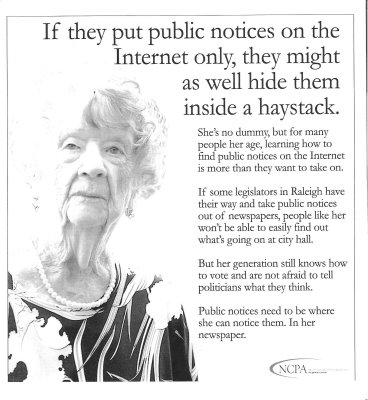


 Yes we can. We just found it on Twitter. And if you came here looking for breaking news about the latest layoffs and cutbacks, you’re wasting your time. This is a daily blog, which is so last year. Instead, subscribe to
Yes we can. We just found it on Twitter. And if you came here looking for breaking news about the latest layoffs and cutbacks, you’re wasting your time. This is a daily blog, which is so last year. Instead, subscribe to 